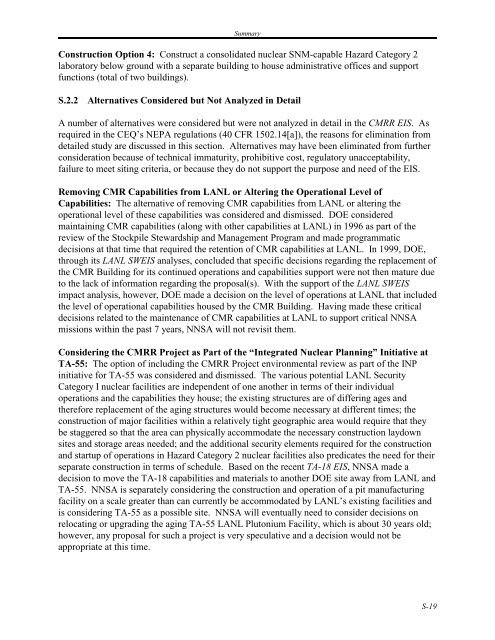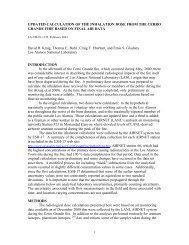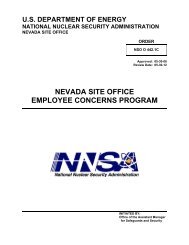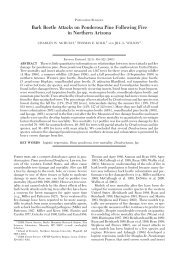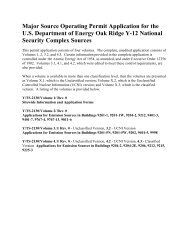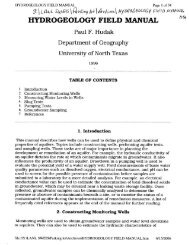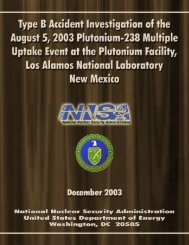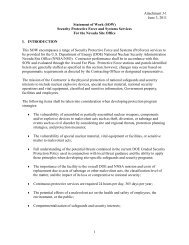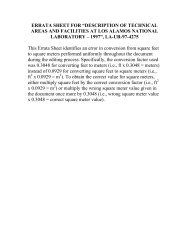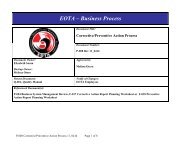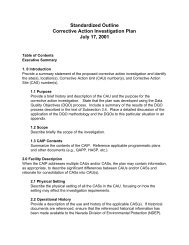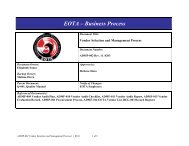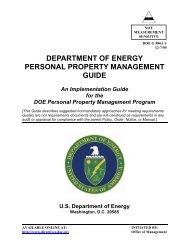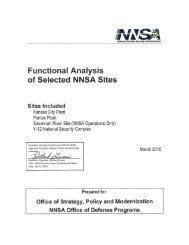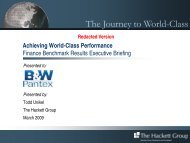- Page 2 and 3: AVAILABILITY OF THE FINAL CMRR EIS
- Page 4 and 5: Final EIS for the Chemistry and Met
- Page 6 and 7: Final EIS for the Chemistry and Met
- Page 8 and 9: Final EIS for the Chemistry and Met
- Page 10 and 11: Final EIS for the Chemistry and Met
- Page 12 and 13: Final EIS for the Chemistry and Met
- Page 14 and 15: Final EIS for the Chemistry and Met
- Page 16 and 17: Final EIS for the Chemistry and Met
- Page 18 and 19: Final EIS for the Chemistry and Met
- Page 20 and 21: ACRONYMS, ABBREVIATIONS, AND CONVER
- Page 22: Acronyms, Abbreviations, and Conver
- Page 25 and 26: COVER SHEET Responsible Agency: U.S
- Page 27 and 28: TABLE OF CONTENTS SUMMARY Page Cove
- Page 29 and 30: ACRONYMS, ABBREVIATIONS, AND CONVER
- Page 31 and 32: SUMMARY This summarizes the U.S. De
- Page 33 and 34: (CMR) Building and the Plutonium Fa
- Page 35 and 36: Summary project but would be driven
- Page 37 and 38: Summary 1996 as part of its review
- Page 39 and 40: Summary Facility (TA-54), and the t
- Page 41 and 42: Summary The No Action Alternative a
- Page 43 and 44: Summary justification for needing A
- Page 45 and 46: Summary radioactive waste generated
- Page 47: Summary No Action Alternative Yes N
- Page 51 and 52: Summary NNSA’s Preferred Alternat
- Page 53 and 54: Summary SANTA FE NATIONAL Los Alamo
- Page 55 and 56: Summary disposal. The primary sourc
- Page 57 and 58: Summary of research laboratory spac
- Page 59 and 60: Summary Table S-2 Operational Chara
- Page 61 and 62: Summary use designation. The existi
- Page 63 and 64: Summary operational at the new CMRR
- Page 65 and 66: Summary Impacts of potential handli
- Page 67 and 68: Summary Table S-3 Summary of Enviro
- Page 69 and 70: Summary S.7 GLOSSARY absorbed dose
- Page 71 and 72: Summary dose equivalent — A measu
- Page 73 and 74: Summary hot cell — A shielded fac
- Page 75 and 76: Summary nuclear material — Compos
- Page 77 and 78: Summary security — An integrated
- Page 79 and 80: 1. INTRODUCTION AND PURPOSE OF AND
- Page 81 and 82: Chapter 1 — Introduction and Purp
- Page 83 and 84: Chapter 1 — Introduction and Purp
- Page 85 and 86: Chapter 1 — Introduction and Purp
- Page 87 and 88: Chapter 1 — Introduction and Purp
- Page 89 and 90: Chapter 1 — Introduction and Purp
- Page 91 and 92: Chapter 1 — Introduction and Purp
- Page 93 and 94: Chapter 1 — Introduction and Purp
- Page 95 and 96: Chapter 1 — Introduction and Purp
- Page 97 and 98: Chapter 1 — Introduction and Purp
- Page 99 and 100:
Chapter 1 — Introduction and Purp
- Page 101 and 102:
Chapter 1 — Introduction and Purp
- Page 103 and 104:
Chapter 1 — Introduction and Purp
- Page 105 and 106:
Chapter 1 — Introduction and Purp
- Page 107 and 108:
2. PROJECT DESCRIPTION AND ALTERNAT
- Page 109 and 110:
Chapter 2 — Project Description a
- Page 111 and 112:
Chapter 2 — Project Description a
- Page 113 and 114:
Chapter 2 — Project Description a
- Page 115 and 116:
Chapter 2 — Project Description a
- Page 117 and 118:
Chapter 2 — Project Description a
- Page 119 and 120:
Chapter 2 — Project Description a
- Page 121 and 122:
Chapter 2 — Project Description a
- Page 123 and 124:
2.6.3 Alternative LANL Sites Chapte
- Page 125 and 126:
Chapter 2 — Project Description a
- Page 127 and 128:
Chapter 2 — Project Description a
- Page 129 and 130:
Chapter 2 — Project Description a
- Page 131 and 132:
Chapter 2 — Project Description a
- Page 133 and 134:
Chapter 2 — Project Description a
- Page 135 and 136:
2.7.7 Disposition of the CMR Buildi
- Page 137 and 138:
Chapter 2 — Project Description a
- Page 139 and 140:
Chapter 2 — Project Description a
- Page 141 and 142:
Chapter 2 — Project Description a
- Page 143 and 144:
Chapter 2 — Project Description a
- Page 145 and 146:
Chapter 2 — Project Description a
- Page 147 and 148:
Resource/Material Categories No Act
- Page 149 and 150:
Final EIS for the Chemistry and Met
- Page 151 and 152:
Final EIS for the Chemistry and Met
- Page 153 and 154:
Final EIS for the Chemistry and Met
- Page 155 and 156:
Final EIS for the Chemistry and Met
- Page 157 and 158:
Final EIS for the Chemistry and Met
- Page 159 and 160:
Final EIS for the Chemistry and Met
- Page 161 and 162:
Final EIS for the Chemistry and Met
- Page 163 and 164:
Final EIS for the Chemistry and Met
- Page 165 and 166:
Final EIS for the Chemistry and Met
- Page 167 and 168:
Final EIS for the Chemistry and Met
- Page 169 and 170:
Final EIS for the Chemistry and Met
- Page 171 and 172:
Final EIS for the Chemistry and Met
- Page 173 and 174:
Final EIS for the Chemistry and Met
- Page 175 and 176:
Final EIS for the Chemistry and Met
- Page 177 and 178:
Final EIS for the Chemistry and Met
- Page 179 and 180:
Final EIS for the Chemistry and Met
- Page 181 and 182:
Final EIS for the Chemistry and Met
- Page 183 and 184:
Final EIS for the Chemistry and Met
- Page 185 and 186:
Final EIS for the Chemistry and Met
- Page 187 and 188:
Final EIS for the Chemistry and Met
- Page 189 and 190:
Final EIS for the Chemistry and Met
- Page 191 and 192:
Final EIS for the Chemistry and Met
- Page 193 and 194:
Final EIS for the Chemistry and Met
- Page 195 and 196:
Final EIS for the Chemistry and Met
- Page 197 and 198:
Final EIS for the Chemistry and Met
- Page 199 and 200:
Final EIS for the Chemistry and Met
- Page 201 and 202:
Final EIS for the Chemistry and Met
- Page 203 and 204:
Final EIS for the Chemistry and Met
- Page 205 and 206:
Final EIS for the Chemistry and Met
- Page 207 and 208:
Final EIS for the Chemistry and Met
- Page 209 and 210:
4. ENVIRONMENTAL IMPACTS Chapter 4
- Page 211 and 212:
Chapter 4 — Environmental Impacts
- Page 213 and 214:
Chapter 4 — Environmental Impacts
- Page 215 and 216:
Chapter 4 — Environmental Impacts
- Page 217 and 218:
Chapter 4 — Environmental Impacts
- Page 219 and 220:
Chapter 4 — Environmental Impacts
- Page 221 and 222:
Chapter 4 — Environmental Impacts
- Page 223 and 224:
Chapter 4 — Environmental Impacts
- Page 225 and 226:
Chapter 4 — Environmental Impacts
- Page 227 and 228:
Chapter 4 — Environmental Impacts
- Page 229 and 230:
Chapter 4 — Environmental Impacts
- Page 231 and 232:
Chapter 4 — Environmental Impacts
- Page 233 and 234:
Chapter 4 — Environmental Impacts
- Page 235 and 236:
Chapter 4 — Environmental Impacts
- Page 237 and 238:
Chapter 4 — Environmental Impacts
- Page 239 and 240:
Chapter 4 — Environmental Impacts
- Page 241 and 242:
Chapter 4 — Environmental Impacts
- Page 243 and 244:
Chapter 4 — Environmental Impacts
- Page 245 and 246:
Chapter 4 — Environmental Impacts
- Page 247 and 248:
Chapter 4 — Environmental Impacts
- Page 249 and 250:
4.4.7.4 Paleontological Resources C
- Page 251 and 252:
a b c Chapter 4 — Environmental I
- Page 253 and 254:
Chapter 4 — Environmental Impacts
- Page 255 and 256:
Chapter 4 — Environmental Impacts
- Page 257 and 258:
Chapter 4 — Environmental Impacts
- Page 259 and 260:
Chapter 4 — Environmental Impacts
- Page 261 and 262:
Chapter 4 — Environmental Impacts
- Page 263 and 264:
Chapter 4 — Environmental Impacts
- Page 265 and 266:
Chapter 4 — Environmental Impacts
- Page 267 and 268:
Chapter 4 — Environmental Impacts
- Page 269 and 270:
4.6.5 Surface and Groundwater Quali
- Page 271 and 272:
4.6.7.4 Paleontological Resources C
- Page 273 and 274:
Chapter 4 — Environmental Impacts
- Page 275 and 276:
Chapter 4 — Environmental Impacts
- Page 277 and 278:
Chapter 4 — Environmental Impacts
- Page 279 and 280:
Chapter 4 — Environmental Impacts
- Page 281 and 282:
Chapter 4 — Environmental Impacts
- Page 283 and 284:
Chapter 4 — Environmental Impacts
- Page 285 and 286:
Chapter 4 — Environmental Impacts
- Page 287 and 288:
Chapter 4 — Environmental Impacts
- Page 289 and 290:
Chapter 4 — Environmental Impacts
- Page 291 and 292:
Chapter 4 — Environmental Impacts
- Page 293 and 294:
Final EIS for the Chemistry and Met
- Page 295 and 296:
Final EIS for the Chemistry and Met
- Page 297 and 298:
Final EIS for the Chemistry and Met
- Page 299 and 300:
Final EIS for the Chemistry and Met
- Page 301 and 302:
Final EIS for the Chemistry and Met
- Page 303 and 304:
Final EIS for the Chemistry and Met
- Page 305 and 306:
Final EIS for the Chemistry and Met
- Page 307 and 308:
Final EIS for the Chemistry and Met
- Page 309 and 310:
Final EIS for the Chemistry and Met
- Page 311 and 312:
Final EIS for the Chemistry and Met
- Page 313 and 314:
6. REFERENCES CEQ (U.S. Council on
- Page 315 and 316:
Chapter 6 — References DOE (U.S.
- Page 317 and 318:
Chapter 6 — References LANL (Los
- Page 319 and 320:
Chapter 6 — References NMAQB (New
- Page 321 and 322:
7. GLOSSARY absorbed dose — For i
- Page 323 and 324:
Chapter 7 — Glossary Atomic Energ
- Page 325 and 326:
Chapter 7 — Glossary capable faul
- Page 327 and 328:
Chapter 7 — Glossary conformity
- Page 329 and 330:
Chapter 7 — Glossary decontaminat
- Page 331 and 332:
Chapter 7 — Glossary effective do
- Page 333 and 334:
Chapter 7 — Glossary fissile mate
- Page 335 and 336:
Chapter 7 — Glossary hazardous ai
- Page 337 and 338:
Chapter 7 — Glossary low-level ra
- Page 339 and 340:
Chapter 7 — Glossary Modified Mer
- Page 341 and 342:
Chapter 7 — Glossary nuclear radi
- Page 343 and 344:
Chapter 7 — Glossary plutonium
- Page 345 and 346:
Chapter 7 — Glossary reference co
- Page 347 and 348:
Chapter 7 — Glossary seismic —
- Page 349 and 350:
Chapter 7 — Glossary threatened s
- Page 351 and 352:
Chapter 7 — Glossary weighting fa
- Page 353 and 354:
Final EIS for the Chemistry Metallu
- Page 355 and 356:
Final EIS for the Chemistry Metallu
- Page 357 and 358:
Final EIS for the Chemistry and Met
- Page 359 and 360:
Final EIS for the Chemistry and Met
- Page 361 and 362:
Final EIS for the Chemistry and Met
- Page 363 and 364:
Final EIS for the Chemistry and Met
- Page 365 and 366:
Final EIS for the Chemistry and Met
- Page 367 and 368:
Final EIS for the Chemistry and Met
- Page 369 and 370:
Final EIS for the Chemistry and Met
- Page 371 and 372:
Final EIS for the Chemistry and Met
- Page 373 and 374:
Final EIS for the Chemistry and Met
- Page 375 and 376:
Final EIS for the Chemistry and Met
- Page 377 and 378:
Final EIS for the Chemistry and Met
- Page 379 and 380:
Final EIS for the Chemistry and Met
- Page 381 and 382:
Final EIS for the Chemistry and Met
- Page 383 and 384:
Final EIS for the Chemistry and Met
- Page 385 and 386:
Final EIS for the Chemistry and Met
- Page 387 and 388:
Final EIS for the Chemistry and Met
- Page 389 and 390:
APPENDIX B EVALUATION OF RADIOLOGIC
- Page 391 and 392:
Appendix B — Evaluation of Radiol
- Page 393 and 394:
Appendix B — Evaluation of Radiol
- Page 395 and 396:
Appendix B — Evaluation of Radiol
- Page 397 and 398:
Appendix B — Evaluation of Radiol
- Page 399 and 400:
Appendix B — Evaluation of Radiol
- Page 401 and 402:
Appendix B — Evaluation of Radiol
- Page 403 and 404:
Appendix B — Evaluation of Radiol
- Page 405 and 406:
a b Appendix B — Evaluation of Ra
- Page 407 and 408:
Appendix B — Evaluation of Radiol
- Page 409 and 410:
Final EIS for the Chemistry and Met
- Page 411 and 412:
Final EIS for the Chemistry and Met
- Page 413 and 414:
Final EIS for the Chemistry and Met
- Page 415 and 416:
Final EIS for the Chemistry and Met
- Page 417 and 418:
Final EIS for the Chemistry and Met
- Page 419 and 420:
Final EIS for the Chemistry and Met
- Page 421 and 422:
| Final EIS for the Chemistry and M
- Page 423 and 424:
Final EIS for the Chemistry and Met
- Page 425 and 426:
Final EIS for the Chemistry and Met
- Page 427 and 428:
Final EIS for the Chemistry and Met
- Page 429 and 430:
APPENDIX D ENVIRONMENTAL JUSTICE D.
- Page 431 and 432:
Appendix D — Environmental Justic
- Page 433 and 434:
Appendix D — Environmental Justic
- Page 435 and 436:
Appendix D — Environmental Justic
- Page 437 and 438:
Appendix D — Environmental Justic
- Page 439 and 440:
Appendix D — Environmental Justic
- Page 441 and 442:
Appendix D — Environmental Justic
- Page 443 and 444:
Appendix D — Environmental Justic
- Page 445 and 446:
Appendix D — Environmental Justic
- Page 447 and 448:
Appendix D — Environmental Justic
- Page 449 and 450:
48160 Federal Register / Vol. 67, N
- Page 451 and 452:
48162 Federal Register / Vol. 67, N
- Page 453 and 454:
Federal Register / Vol. 68, No. 94


